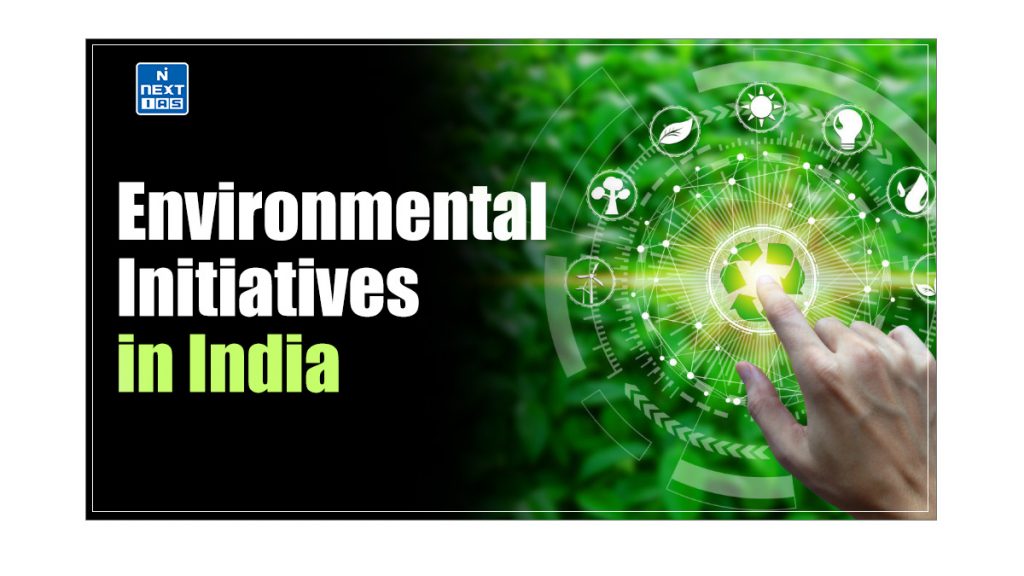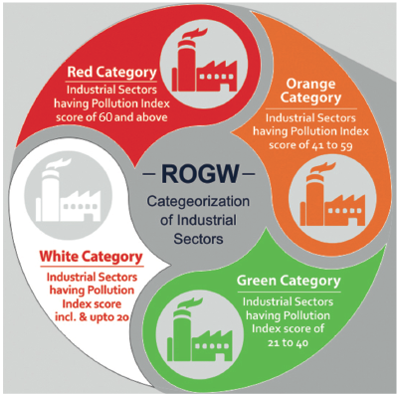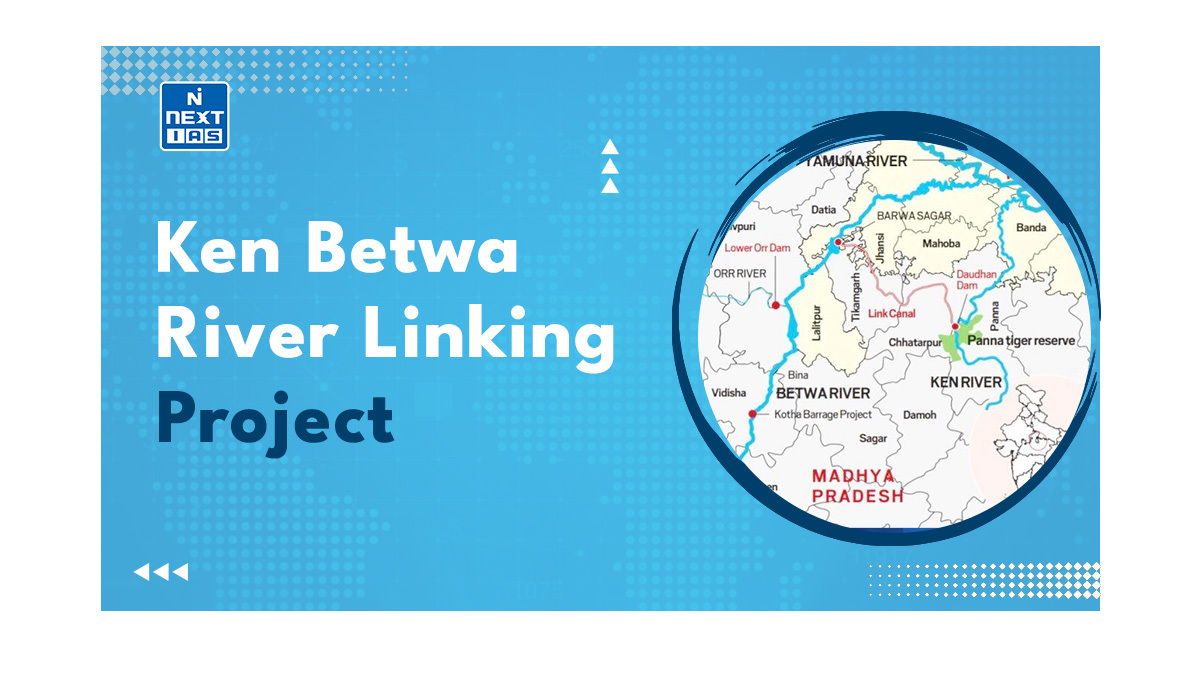
A range of environmental initiatives in India have been launched to protect and conserve the environment and promote sustainable development. Forming a key component of Environmental Governance in India, these environmental initiatives in India have played a crucial role in balancing economic growth with environmental sustainability. This article aims to study in detail the key Environmental Initiatives in India, their objectives, major provisions, significance, and other related aspects.
Meaning of Environmental Initiatives
- Environmental Initiatives refer to actions, programs, policies, and projects designed to protect, conserve, and improve the natural environment.
- These initiatives are typically aimed at addressing environmental challenges such as pollution, climate change, habitat loss, and resource depletion.
- They may be implemented by governments, NGOs, communities, or individuals and can include a variety of activities, such as conservation programs, pollution control programs, etc.
Key Environmental Initiatives in India
- After the United Nations Conference on Human Environment in Stockholm in 1972, a series of environmental initiatives in India were launched.
- These initiatives span governmental policies, non-governmental programs, and community-driven projects, which are aimed at promoting environmental sustainability, conservation, and pollution control.
- These initiatives, along with environmental laws and organisations, form a vital component of Environmental Governance in India.
- Some of the prominent environmental initiatives in India include:
- Joint Forest Management (JFM)
- National Bamboo Mission (NBM)
- National Wildlife Action Plan (NWAP)
- Comprehensive Environmental Pollution Index (CEPI)
- Lighting a Billion Lives (LaBL)
- Eco-Mark
- Urban Services Environmental Rating System (USERS)
- Biodiversity Conservation and Rural Livelihood Improvement Project (BCRLIP)
- National Clean Energy Fund (NCEF)
- National Electric Mobility Plan (NEMP)
- Science Express Biodiversity Special (SEBS)
- National Plan for Conservation of Aquatic Ecosystems (NPCA)
- Mangroves for Future (MFF),
- National Afforestation Programme (NAP), etc.
Each of these environmental initiatives in India has been discussed in detail in the sections that follow.
What is Environmental Governance?
- Environmental Governance refers to the systems and processes in place to manage environmental resources and protect the environment.
- It encompasses the laws, policies, initiatives, and institutions that guide human interactions with nature.
- Environmental Governance in India comprises the rules, practices, policies and institutions that shape how people in the country interact with the environment.
Read our detailed article on:
- Environmental Governance in India
- Environmental Laws in India
- Environmental Organisations in India
Joint Forest Management (JFM)
- Joint Forest Management (JFM) is a community-based approach to forest conservation and management in India that emerged as a response to the challenges of forest degradation and the need for sustainable forest management.
- In a shift from traditional state-centric forest management in the country, this environmental initiative envisages active participation of the local communities in the protection and sustainable use of forest resources.
- Joint Forest Management (JFM) was introduced under the National Forest Policy of 1988, where state forest departments collaborate with local forest-dwelling and forest fringe communities to safeguard and manage forests, while also sharing the associated costs and benefits with them.
- This is what makes it one of the unique environmental initiatives in India.
Read our detailed article on Joint Forest Management (JFM).
National Bamboo Mission (NBM)
- The National Bamboo Mission (NBM) is one of the environmental initiatives in India, run by the Government of India aimed at harnessing the potential of bamboo as a versatile and sustainable resource.
- It was launched as part of the National Mission for Sustainable Agriculture (NMSA) under the Ministry of Agriculture and Farmers’ Welfare.
- The mission seeks to promote the holistic development of the bamboo sector in the country, which, in turn, will contribute to rural livelihoods, industrial development, and environmental sustainability.
Read our detailed article on the National Bamboo Mission (NBM).
National Wildlife Action Plan (NWAP)
- The National Wildlife Action Plan (NWAP) is a policy framework formulated by the Government of India to address the conservation needs of the country’s diverse wildlife.
- It was first introduced in 1983 and subsequently updated in the later years.
- It outlines strategic actions and priorities for the protection and management of wildlife and their habitats.
- The plan aligns with India’s broader environmental and biodiversity goals and adheres to international conventions on wildlife conservation.
Read our detailed article on the National Wildlife Action Plan (NWAP).
Comprehensive Environmental Pollution Index (CEPI)
- The Central Pollution Control Board (CPCB) developed the concept of Comprehensive Environmental Pollution Index (CEPI) in 2009-10 as a tool for conducting thorough environmental assessments of major industrial clusters.
- The index captures various dimensions of the environment, including air, water and land.
- It is a rational number that shows the environmental quality at a given location.
- This would help in the formulation of remedial Action Plans for the identified critically polluted areas.
Features of Comprehensive Environmental Pollution Index (CEPI)
The salient features of the revised CEPI are as follows:
- It can also be applied to locations other than industrial clusters.
- The outcome of the CEPI assessment shall not be used by the bankers for any sort of financial freezing decisions on industry funding.
- It shall be an early warning tool.
- All the polluting sources identified in the area shall be notified and brought into the public domain.
- The State Government shall notify the area on a properly scaled map and also issue public advisories that such an area will be exclusively meant for industrialisation as per the State land use plan with no public-related infrastructure to be promoted.
Categorisation of Industries Basis on Pollution Index

| Categories | Score |
|---|---|
| Red | Industrial Sectors having Pollution Index score of 60 and above |
| Orange | Industrial Sectors having Pollution Index score of 41 to 59 |
| Green | Industrial Sectors having Pollution Index score of 21 to 40 |
| White | Industrial Sectors having Pollution Index score incl. & upto 20 |
Lighting a Billion Lives (LaBL)
- It is a global initiative which aims to facilitate clean energy access and the ensure last mile delivery of energy services for basic and productive use.
- The initiative aims to enable energy-poor communities to transition from traditional, inefficient energy sources to modern, more efficient, and sustainable energy solutions.
- Key objectives of the Lighting a Billion Lives (LaBL) initiative are as follows:
- It will replace inefficient and harmful lighting and cooking methods with efficient, affordable and reliable clean energy alternatives.
- It will enable the productive use of clean energy for enhanced education, better health and improved livelihood opportunities – thereby empowering the poor to escape the poverty trap.
Eco-Mark
- The Ministry of Environment instituted a scheme for labelling of Environment-Friendly Products in 1991.
- It operates on a national level, offering accreditation and labelling for household and other consumer products.
- To obtain the Eco-Mark label, a product must meet specific environmental criteria in addition to the quality standards set by the Indian Standards for that product.
- A product is considered environmentally friendly if it is produced, used, or disposed of in a manner that significantly minimises the harm it would otherwise cause to the environment.
- Eco Mark scheme has a unique logo and its message has the ability to reach out to the people and can help to promote a greater awareness of the need to be kind to the environment.
- The licence is granted for a minimum period of one year and is renewed subsequently for the same period, after reassessment of the products.
- The manufacturer must ensure that the product qualify the quality criteria as per Indian Standard before applying to BIS for Eco Mark.
- The major objectives of the Eco-Mark initiative are as follows:
- To provide an incentive to manufacturers and importers to reduce the environmental impact of products.
- To reward genuine initiatives by companies to reduce the adverse environmental impact of their products.
- To ensure citizens purchase products that have less harmful environmental impacts.
- To improve the quality of the environment and encourage the sustainable management of resources.
Urban Services Environmental Rating System (USERS)
- Rapid urbanisation and development have led to the degradation of the environment in urban areas.
- There is, therefore, a need for creating a new pressure mechanism, which highlights the issue and facilitates information sharing on the subject thereby enabling adoption of better standards/practices.
- The Urban Services Environmental Rating System (USERS) Project, funded by UNDP and implemented by Tata Energy Research Institute, addressed some of these problems.
- In order to arrive at a holistic picture considering all related aspects, Performance Measurement Indicators (PMIs) were developed for all three basic services: water supply, sewerage and solid waste management under three different categories: Management indicators, Technical indicators and Financial indicators.
- Separate manuals on performance measurement and management information systems have also been developed for the four agencies in the pilot cities covering all three municipal services.
- The project recommends different approaches for promoting, developing and sustaining the concept of PMI systems in local Governments: legislative and regulatory mechanisms, market-based financial instruments and/or involving community-based pressure groups.
Biodiversity Conservation and Rural Livelihood Improvement Project (BCRLIP)
- The Biodiversity Conservation & Rural Livelihood Improvement Project (BCRLIP) aims to conserve biodiversity in selected landscapes, including wildlife-protected areas or critical conservation areas while improving rural livelihoods through participatory approaches.
- The project intends to build on these models and extend the lessons learnt to other globally significant sites in the country to strengthen linkages between conservation and improving livelihoods of local communities that live in the neighborhood of biodiversity rich areas-as well as to enhance the local and national economy.
- The major objectives of the Biodiversity Conservation and Rural Livelihood Improvement Project (BCRLIP) are as follows:
- A multi-sector and multi themed project, it aims at improving rural livelihood through participatory approaches and conserving Biodiversity in selected landscapes including wildlife protected areas.
- The project is intended to be built on the model like Joint Forest Management which strengthen linkages between conservation efforts and improvement of livelihoods of local communities residing near biodiversity rich areas.
- It tries to address local livelihood improvement issues in the context of biodiversity conservation in a single project.
National Clean Energy Fund (NCEF)
- Through Finance Bill 2010-11, a corpus fund called the National Clean Energy Fund (NCEF) was created.
- This fund was collected out of cess on coal produced/imported based on the polluter pays principle.
- This fund is to be used for financing and promoting clean energy initiatives, funding research in the area of clean energy or for any other related purposes.
- Subsequently, the scope of the fund has been expanded also to cover clean environment initiatives.
- The projects eligible for financing under the NCEF include
- Innovative schemes like the Green Energy Corridor for boosting the transmission sector,
- Namami Gange,
- Green India Mission,
- Jawaharlal Nehru National Solar Mission (JNNSM)’s installation of solar photovoltaic (SPV) lights and small capacity lights,
- Installation of SPV water pumping systems, SPV Power Plants,
- Grid Connected Rooftop SPV Power Plants,
- Pilot project to assess wind power potential, etc.
- The coal cess has been increased to Rs. 400 per tonne in the Union budget 2016-17 and the same has been renamed as “Clean Environment Cess”.
- Accordingly, the name of NCEF has been changed to National Clean Energy and Environment Fund (NCEEF).
- However, the Goods and Services Tax (Compensation to States) Act, 2017 provides that coal cess, along with some other cess on pan masala, tobacco, aerated water etc. would constitute GST Compensation Fund and the same would be utilized to compensate the States for five years which in turn would compensate them for potential losses on account of GST implementation.
Analysis of NCEF
- The effort of the Centre to financially support clean energy initiatives by imposing a cess on coal producers seems to have failed.
- Of the aggregate amount collected between 2010 & 2017, only about 35% has been transferred to the NCEF, which itself remained under utilised and about 70% of NCEF fund has went to the ministry of new and renewable energy (MNRE).
- It is essential that the NCEF be more efficiently and strategically employed as an enabler of large-scale change in the renewable sector.
- The fund can be used in applied research and the development of viable technologies and business models for clean energy services in India.
National Electric Mobility Mission Plan (NEMMP)
- In 2013, the Government of India launched the National Electric Mobility Mission Plan (NEMMP) 2020.
- It promotes hybrid and electric vehicles in the country to achieve national fuel security.
- An ambitious target has been set to achieve 6-7 million sales of hybrid and electric vehicles annually starting from 2020 onwards.
- It is expected to save 9500 Million Liters of crude oil, equivalent to a saving of around Rs. 62000 Cr.
- The government has launched the scheme Faster Adoption and Manufacturing of (Hybrid & Electric Vehicles) FAME India under NEMMP 2020 in the Union Budget 2015-16.
- The second phase of the FAME scheme was launched in 2019 and has been extended to 2021.
Likely Benefits of National Electric Mobility Mission Plan (NEMMP)
- Significant savings in liquid fuel consumption, thereby lowering the petroleum import bill.
- Significant reductions in emissions and also net decrease in CO2 emissions on a “well to wheel” basis.
- May ensure future energy security and give a push to the automobile manufacturing sector to create electric vehicles giving an impetus to the Make in India initiative.
Science Express Biodiversity Special (SEBS)
- Science Express was an innovative mobile science, state-of-the-art exhibition to create widespread awareness of the unique biodiversity of India, climate change and related issues among various sections of society, especially students.
- It was a unique collaboration between the Department of Science & Technology (DST) and the Ministry of Environment, Forests & Climate Change (MoEFCC), Govt. of India.
- Some coaches were solely dedicated to showcasing the myriad biodiversity spread across the bio-geographical zones of India, like Trans-Himalaya & Himalaya, the Gangetic Plain, etc.
- Other coaches exhibited on the themes of Climate Change, Biodiversity and Water, Sustainable Environment and Energy Conservation.
National Plan for Conservation of Aquatic Ecosystems (NPCA)
- The National Plan for Conservation of Aquatic Ecosystems (NPCA) is a conservation programme for lakes and wetlands.
- It is a centrally sponsored scheme and is being implemented by the Ministry of Environment.
- It was formulated by merging the National Lake Conservation Plan (NLCP) and the National Wetlands Conservation Programme (NWCP).
- Under the scheme, central assistance is provided based on proposals received from state governments that conform to the guidelines and budget availability.
- The scheme covers various activities such as shoreline protection, lakefront development, interception, diversion and treatment of wastewater, in-situ cleaning, i.e. desilting and de-weeding, bioremediation, stormwater management, catchment area treatment, lake beautification, survey and demarcation, fisheries development, bio fencing, weed control, biodiversity conservation, community participation, education and awareness creation, etc.
- It aims for the comprehensive conservation and restoration of lakes and wetlands to achieve improved water quality, enhance biodiversity, and restore ecosystems through an integrated, multidisciplinary approach and a unified regulatory framework.
Mangroves for the Future (MFF)
- Mangroves for the Future (MFF) is a unique partner-led initiative to address the challenges to coastal ecosystems and livelihood issues.
- It is co-chaired by IUCN and UNDP and tries to promote investment in coastal ecosystem conservation for sustainable development.
- Apart from the Mangroves, the MFF also includes all types of coastal ecosystem, such as estuaries, lagoons, coral reefs, sandy beaches, seagrass and wetlands.
- Established in 2006, Mangroves For the Future (MFF) is currently in its third phase (2015-2018).
Countries Associated with the Mangroves for the Future (MFF) Initiative
- Member Countries: Bangladesh, Cambodia, India, Indonesia, Maldives, Myanmar, Pakistan, Seychelles, Sri Lanka, Thailand, and Vietnam.
- Outreach Countries: Malaysia
- Dialogue Countries: Kenya and Tanzania
Objectives of the Mangroves for the Future (MFF) Program
The major objectives of the Mangroves for the Future (MFF) initiative are:
- Improve, share and apply knowledge to support the conservation, restoration and sustainable use of coastal ecosystems.
- Strengthen Integrated Coastal Management institutions and empower civil society (including local communities) to engage in decision-making and management that conserves, restores, and sustainably uses coastal ecosystems.
- Enhance coastal governance at all levels (regional, national, provincial, district and community) to encourage integrated management programmes and investments that are ecologically and socio-economically sound and promote human well-being and security.
Mangroves for the Future (MFF) Initiative in India
- India is home to a variety of coastal and marine ecosystems that are storehouses for biodiversity.
- From an economic perspective, these coastal and marine ecosystems are of great importance to India.
- Approximately 20 per cent of India’s population lives in coastal areas, with a large proportion based in coastal urban centres like Mumbai, Chennai and Kolkata.
- MFF in India works at the national level by networking, influencing policy issues, conducting training missions and through regional coordination activities.
- At the local level, community networking, experience sharing, and site-specific actions are the core activities under MFF.
- MFF’s work programme in India is overseen by a National Coordination Body (NCB) under the guidelines provided by the National Strategic and Action Plan (NSAP).
- The body comprises a range of Government departments, NGOs, intergovernmental organisations, and academic institutions.
- Under India’s National Social Assistance Programme (NSAP), four priority areas have been identified in relation to the MFF.
- Environmentally sustainable livelihoods to reduce pressure on coastal ecosystems.
- Plantation of mangroves for creating green belts.
- Civil society awareness, participation, coastal decision making and sustainable financing.
- Improving knowledge gaps
National Afforestation Programme (NAP)
- The National Afforestation Programme (NAP) is a flagship scheme of NAEB, launched in 2002 with the aim of planting trees in the country’s degraded forests.
- It provides physical and capacity-building support to the forest development agencies, which are the main organs of Joint forest management programmes in India.
- The National Afforestation and Eco-Development Board (NAEB) operates the National Afforestation Programme (NAP) as a Centrally Sponsored Scheme under the MoEF&CC.
- The programme is monitored and evaluated internally by the FDAs (Forest Development Agencies) and also through concurrent, independent agencies, including the Indian Council of Forestry Research and Education (ICFRE), Dehradun.
- The Forest Survey of India monitors the area covered under plantation and the survival rate of plants.
Conclusion
A range of Environmental Initiatives in India reflect a broad and integrated approach to addressing the country’s ecological challenges. By implementing these environmental initiatives in India, the country aims to achieve a balance between economic growth and environmental sustainability. Continued efforts in these areas will be crucial for ensuring a healthier environment and improving the quality of life for future generations.
Frequently Asked Questions (FAQs)
What is the Green Initiative?
The Green Initiative, also known as environmental initiative, generally refers to a broad set of actions or programs aimed at promoting environmental sustainability and reducing ecological impact.
What are the various environmental reform initiatives taken in India?
Some of the notable environmental initiatives in India include – the Environment Protection Act, 1986; Wildlife Protection Act, 1972; National Action Plan on Climate Change (NAPCC); etc.






